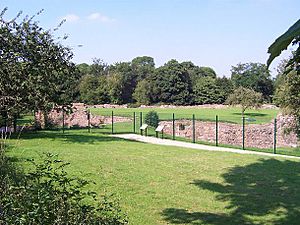Weoley Castle (house) facts for kids
Quick facts for kids Weoley Castle |
|
|---|---|
| Birmingham, England | |
 |
|
| Lua error in Module:Location_map at line 420: attempt to index field 'wikibase' (a nil value). | |
| Type | Fortified manor house |
| Site information | |
| Owner | Birmingham City Council |
| Open to the public |
Partially |
| Official name | Weoley Castle |
| Reference no. | 1005905 |
|
Listed Building – Grade II
|
|
| Official name | Remains of Weoley Castle |
| Designated | 25 April 1952 |
| Reference no. | 1075769 |
| Condition | Ruined |
Weoley Castle (pronounced WEE-lee) is what's left of a strong, old house. It's in the Birmingham area of the West Midlands, England. This area is mostly homes today.
Birmingham City Council owns the castle ruins. Birmingham Museums Trust helps manage it as a community museum. Weoley Castle is a special place. It is a Grade II listed building and a Scheduled monument. This means it's protected because of its history. It was once on a list of historic places needing repair. But after some work, it was removed from that list in 2009.
Contents
The Story of Weoley Castle
Early Days and Norman Beginnings
Archaeologists have found clues that Weoley Castle started in the Norman times. This was a long time ago! The site was surrounded by a moat, which is a ditch filled with water. There was also a bank of earth with a wooden fence on top. This fence was called a palisade.
Building and Changes Over Time
In 1264, a man named Roger de Somery got permission to add battlements to Weoley Castle. Battlements are the parts of a castle wall with gaps for shooting arrows. A survey from 1422 shows us what the building looked like back then.
They found wooden buildings from the early 1200s at the site. These buildings likely date back to around 1264. They show early ways of using wooden boards for walls.
From Castle to Ruin
By the 1600s, Weoley Castle was already known as a "ruined castle." It was no longer being used as a home or fortress. Around the same time, a farmhouse was built nearby. Today, only a brick wall and a few apple trees are left from that farm.
In the 1700s, the Dudley Canal was dug along the northern edge of the castle. Workers dumped the extra dirt from the canal into the moat. Stones from the ruined castle were even used to build bridges over the canal.
Later Ownership
At some point in the 1800s, the ruins belonged to Joseph Frederick Ledsam. He was a local businessman. He was also a leader in the London and North Western Railway company.

